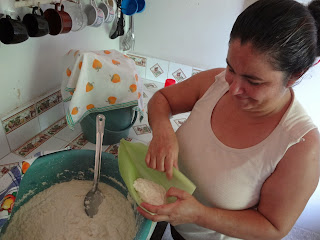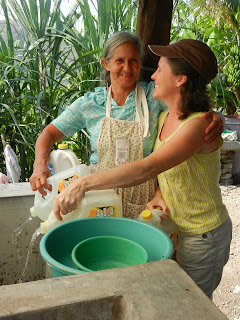I had never made tamalitos and asked my neighbor, Noya, if she would teach me how. So she invited me into her kitchen to learn. Tamalitos are only made with new fresh corn that still has some "milk" in the kernels. It's a simple food of ground corn and a little sugar.
The corn is not shucked in the usual way of simply pulling off the tulsa, or husks, but rather by first cutting around the base to preserve the "tulsa" for wrapping up the tamalito.
Here's our bucket of "tulsa" ready.
We had to go across town (~4 blocks) for our next step to grind the corn. The woman in the blue shirt has a little home business of running a big electric grinder. She charged me 50 cents, which is the normal rate.
The grains of corn were passed through twice to be extra fine for making tamalitos.
Back in Noya's kitchen, we put a little sugar into the ground corn and then put a spoonful of the mixture into the "tulsa." Noya made it look way easier than it really was.
Basically, each tulsa gets a big spoonful of very liquidy corn glop. The big trick was keeping the corn glop in the tulsa as I rolled the edges around the glop and then turn up the end. Trust me, it takes practice... or maybe being born Honduran. :)
After each tulsa is filled, rolled and closed off on one end, it's put in a pot. This is another skill that's very easy to take for granted as they have to be placed together just so in order that they don't fall over in the pot.
Here's our full pot almost ready to be put on the fire.
Here you can see the pot with the wood fire behind it.
The final step before cooking was putting a few more pieces of "tulsa" over all the tamalitos and then carefully pouring in about an inch or two of hot water so as to steam the rolls. After the lid was on the top of the pot, we wait. The tamalitos cooked for about 45 minutes, until they were firm.
Here's a picture of a cooked tamalito (right) alongside a tamale (left). (Tamales are made with corn, too, but a completely different recipe.) Often our Honduran friends will make a meal of just tamalitos. While we do well to eat one or two because they are so filling, our friends will eat four, five, six or more in one sitting!
A week later, Matt and I decided to try and make them ourselves. Halfway through, we had Noya come over to check on us. She was excited to see "her students" practicing their new skill set!
¡Buen provecho! (Enjoy your meal!)

































